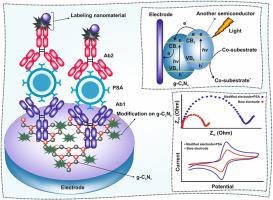Photoelectrochemical biosensors: Prospects of graphite carbon nitride-based sensors in prostate-specific antigen diagnosis
IF 4.6
Q2 MATERIALS SCIENCE, BIOMATERIALS
引用次数: 0
Abstract
Prostate cancer (PC) is very common in old age and causes many deaths. Early diagnosis and monitoring of the progress of the disease and the effectiveness of PC treatment are critical. On the other hand, choosing a specific biomarker for PCs is essential. Prostate-specific antigen (PSA) is a specific biomarker secreted in the prostate epithelial cells, which increases in cancer cells. Between all employed sensing mechanism, electrochemical sensors based on nanomaterials have created many hopes. Meanwhile, graphite carbon nitride (g-C3N4) is interested in developing photoelectrochemical sensors due to its large surface area, stability, easy modification, and good photoelectronic properties. In this review, electrochemical sensors based on nanocomposites containing g-C3N4 have been investigated in PSA detection. After providing an overview of the characteristics of g-C3N4 and cancer biomarkers, it reviews the strategies and mechanisms involved in identifying PSA. Different approaches to photoelectrochemistry, impedimetric immunosensors, photocatalysis, and luminescence have been used in diagnostic mechanisms. Then, challenges and prospects for electrochemical sensors based on nanocomposites containing g-C3N4 in PSA detection have been analyzed. The recent review generally opens an efficient view in PSA diagnosis and the application of g–C3N4–based electrochemical sensors in personalized medicine diagnosis and treatment.

光电化学生物传感器:基于氮化石墨的传感器在前列腺特异性抗原诊断中的应用前景。
前列腺癌(PCs)在老年人中非常常见,并导致许多人死亡。早期诊断、监测疾病进展和癌症治疗效果至关重要。另一方面,选择前列腺癌的特异性生物标记物也至关重要。前列腺特异性抗原(PSA)是前列腺上皮细胞分泌的一种特异性生物标志物,在癌细胞中会增加。在所有采用的传感机制中,基于纳米材料的电化学传感器给人们带来了许多希望。与此同时,氮化石墨(g-C3N4)因其比表面积大、稳定性好、易于改性和良好的光电特性而在光电化学传感器的开发中备受关注。本综述研究了基于含 g-C3N4 纳米复合材料的电化学传感器在 PSA 检测中的应用。在概述了 g-C3N4 和癌症生物标记物的特性之后,本综述回顾了识别 PSA 所涉及的策略和机制。诊断机制采用了光电化学、阻抗免疫传感器、光催化和发光等不同方法。然后,分析了基于含 g-C3N4 纳米复合材料的电化学传感器在 PSA 检测中面临的挑战和前景。最近的综述总体上为 PSA 诊断以及基于 g-C3N4 的电化学传感器在个性化医学诊断和治疗中的应用开辟了一条有效的途径。
本文章由计算机程序翻译,如有差异,请以英文原文为准。
求助全文
约1分钟内获得全文
求助全文

 求助内容:
求助内容: 应助结果提醒方式:
应助结果提醒方式:


